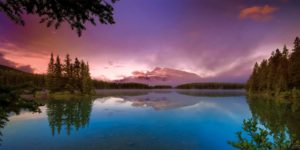What makes a Good Landscape Photo?
In general, there are several elements that gain the initial interest of the viewer, Bold colour, Unique textures, Simple shapes and Appealing curves. However, there are many other considerations. Photography is often referred to as drawing with light. That is the translation of the word photography. Photographers draw with light as they capture the scene in front of them when the shutter is fired off. Whether it is images of the Rocky Mountains, the vase on the table or any other subject, in colour or black and white, photography is drawing with light! While having bold colours, textures, shapes and curves in your landscape image, is that enough to make it a good image?
Landscape photography has ( arguably) 3 major styles: Representational, Abstract and Impressionistic. And while the elements mentioned above, and the elements of graphic design, play significant roles in making a “good” photographic image, they have differing impacts and roles depending on the style of landscape image you are viewing or wish to take. For me, as a Landscape Photographer taking pictures of the Rocky Mountains, it is a fun and intriguing challenge to get the elements – colour, texture, shape and light – all aligned, and then composed to make an impactful landscape mountain photo. I work in the Canadian Rockies and Banff, Jasper, Yohoo and Kootenay National Parks. So my pictures of the Rocky Mountains, most would classify, as Representational photography. Though not all are, and this is why trying to classify one’s work as any one style, is always subjective.

The Representational style aims to give the viewer a realistic representation of the scene – no props or artificial components are added! It is also called straight or descriptive photography. With Abstract the goal is more to stimulate a strong emotion in the viewer still using colour, tone, texture and lines/shapes. Some would say this is a more creative endeavour with your images. Impressionist photography is an impression of life and focuses on capturing atmosphere, light and movement while not prioritizing sharpness ( not focus ). Regardless of the style, regardless of the type ( Mountain Photography, Seascapes, Forests, Sunrise/Sunset, Long Exposure, Time-lapse or Panoramas – it is still drawing with light!
It is said that in today’s digital era, there are 4 pillars of Landscape ( or any ) Photography: Light, Composition, Location ( Subject ), and Processing. This last one, with the growth and use of AI ( Artificial Intelligence ) has greatly impacted Landscape Photography and led to deep and diverse discussions as the differing philosophies collide. ( see my Blog Post “Digital Darkroom “ ). As the discussions go on, and as AI becomes more and more pervasive, the realm of photography, especially landscape photography, is undergoing changes in philosophy and outlook. ( One can look at the rules for entry into the Natural Landscape Photography Awards to get an insight into the changing outlooks and philosophies in Landscape Photography). Whether your intention is to make prints for sale, or simply capture the scene for a home slide show on your computer – to me the MOST vital element is LIGHT. The others fall into place after that. However, ask 10 photographers which is more important and you may well get 10 different replies!
In my view, to answer the opening Question – it is you, the viewer – that makes a photo image “good”. I aim to transport you, the viewer, to the location (subject) I have sought out to capture in that Special Moment of Light, Location/Subject and Composition. If you are engaged and enjoy looking at a photo image, if you feel like you are there standing looking at the view captured – then for you it is GOOD. And that, I think -is the best indicator of a “good photo “.

